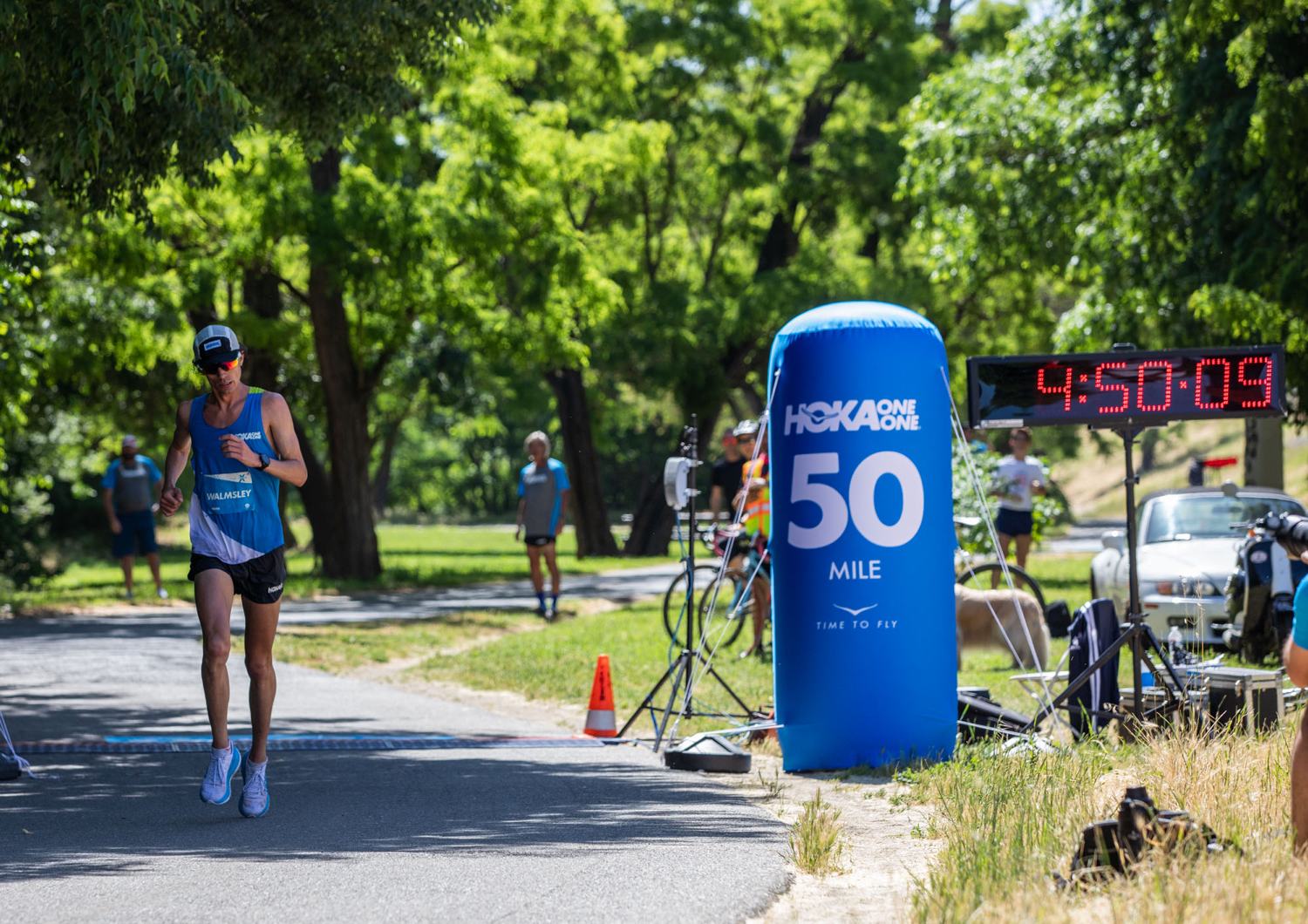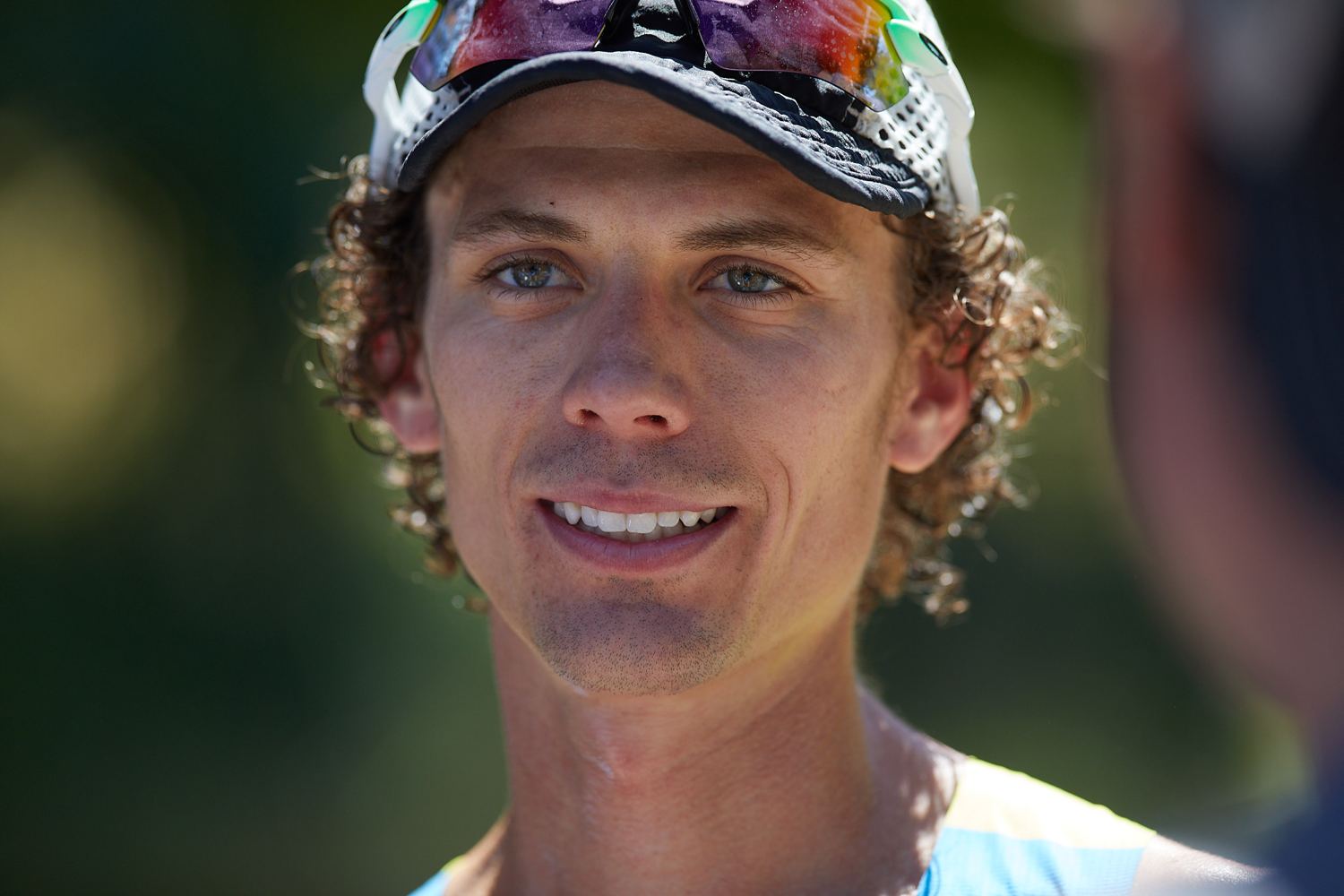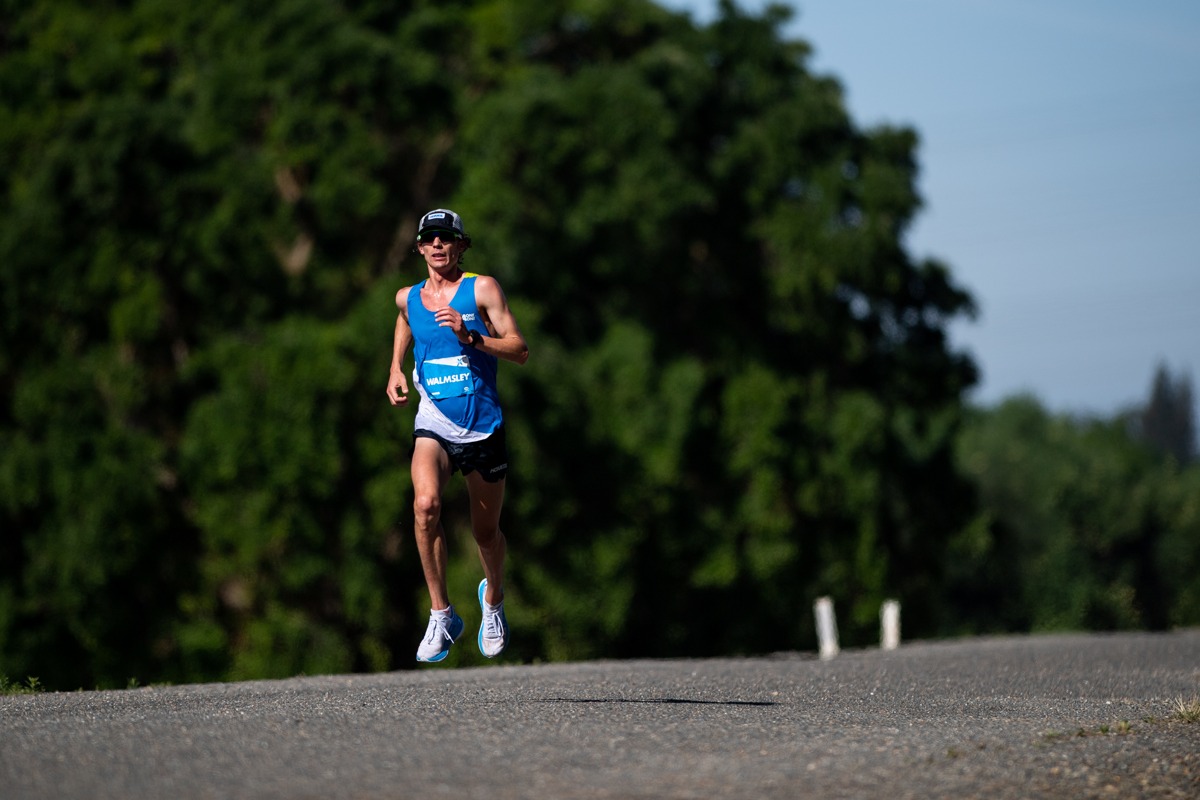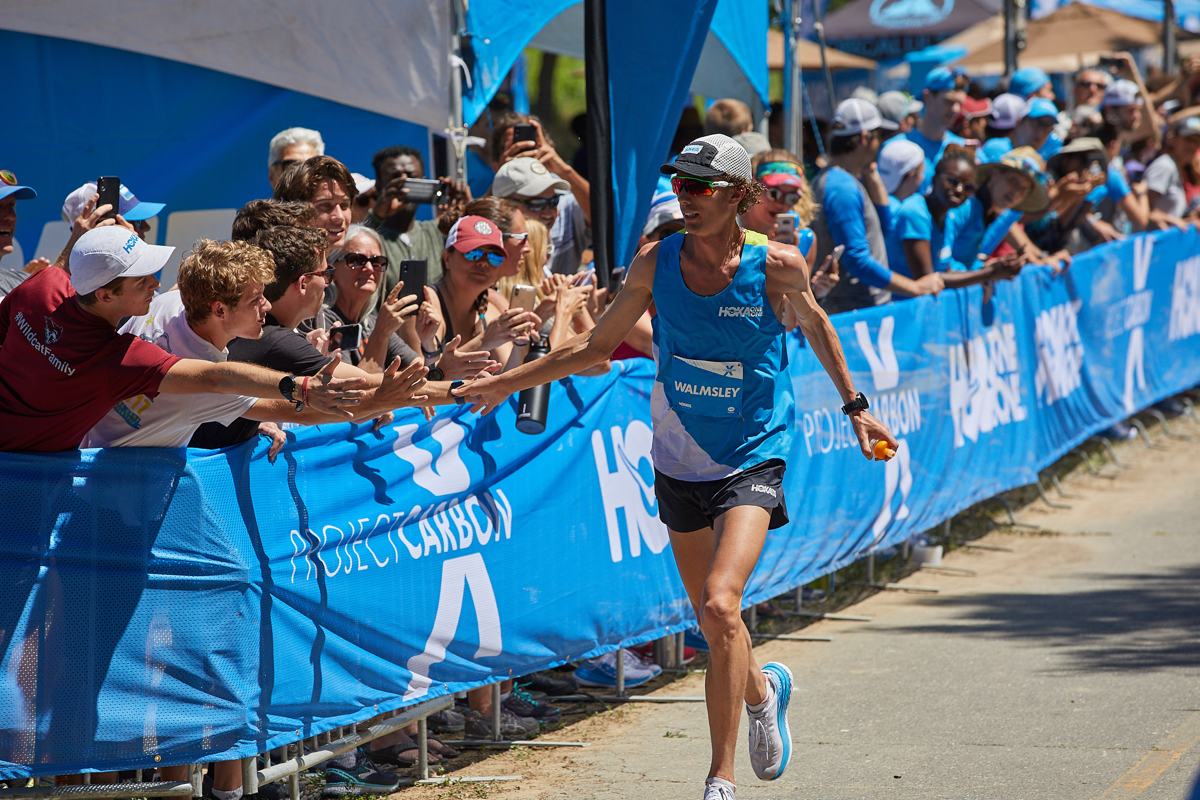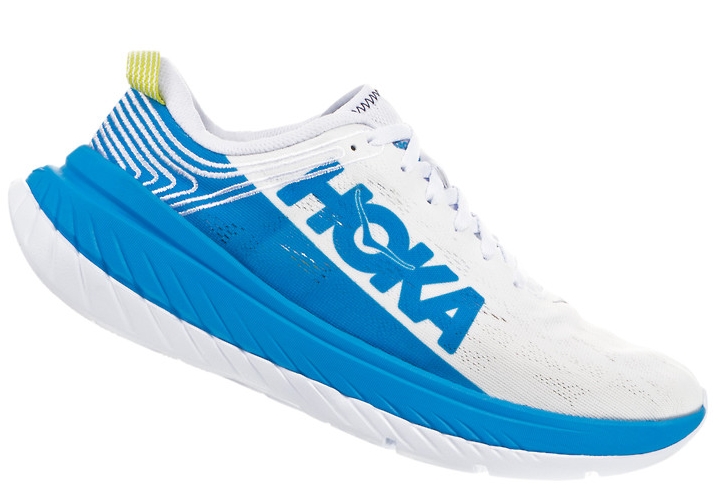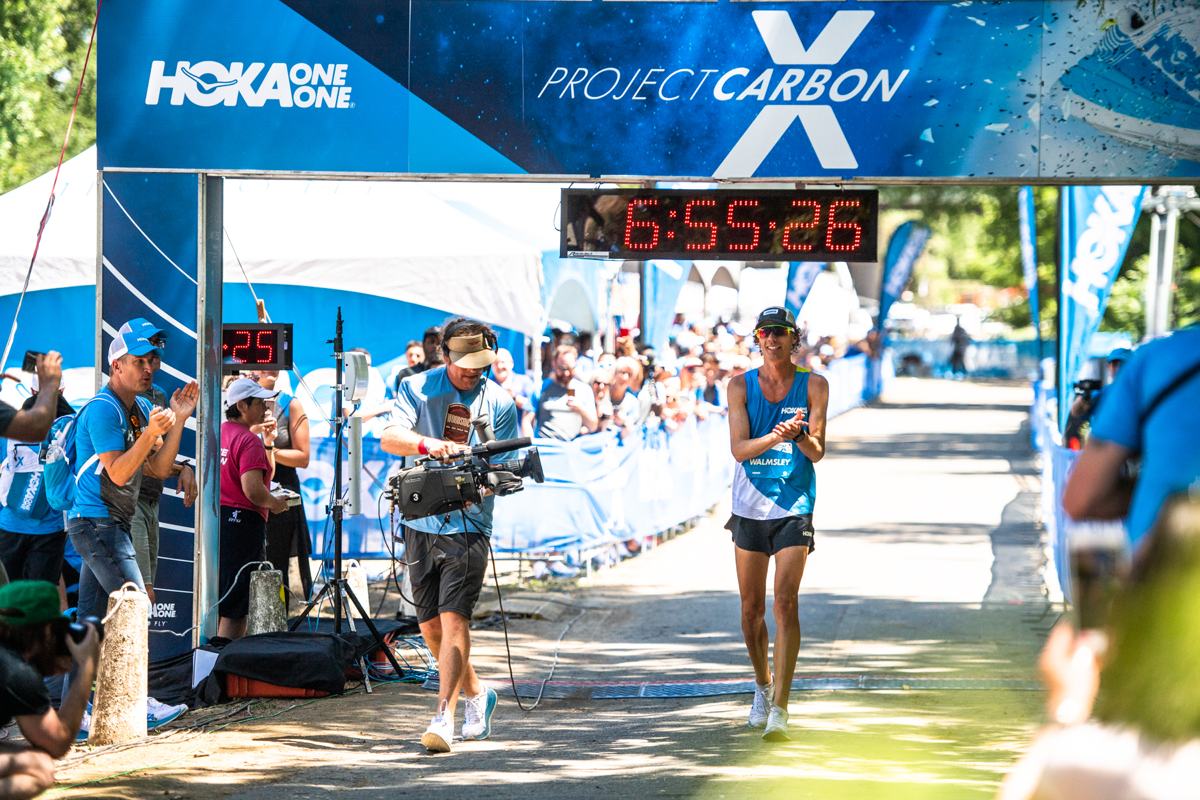Jim Walmsley ran 4:50:08 to set a new 50-mile world record at the 2019 Hoka One One Project Carbon X event outside Sacramento, California on May 4, 2019. The previous world record of 4:50:51 was set by Bruce Fordyce 35 years ago, in 1984. In the following interview, Jim talks about how the event came together, how his attempts at both the 50-mile and 100-kilometer world records played out, what he thinks of the Hoka One One Carbon X shoe, and how he’s now transitioning to Western States 100 training.
iRunFar: Hey, Jim. Two weekends ago you ran 50-mile record of 4:50:08 during the Hoka One One Project Carbon X event. What does setting this record feel like in retrospect?
Jim Walmsley: The coolest part is that it’s concrete. It is done for a fastest time, so it is comparable. You can compare it apples to apples. In trail running, it’s more about the story. Whereas this one is more comparable. The age of the record is pretty nuts, and the American record was even older. That definitely drew me to the 50-mile distance. Also the idea of [setting the 50-mile record while] en route to 100k, but that did not quite work out.
iRunFar: We will get into that as we go along here. I hadn’t even thought to ask it, but your apples to apples statement makes me think, if you have been competing for a while, you can kind of compare apples to oranges for your own performances. Obviously, this is a world record, but how does this rank up there with crushing the Western States record? Was this your absolute best ultramarathon, or have you had better?
Walmsley: I made mistakes on race day. I wasn’t fully committed to a road ultra quite yet. A lot of my training was still on the trails with the foresight of Western States this summer, so catering my training to both. So not quite in Western States training yet but getting my body ready in [the last] block to do the block I’m starting now. But at the same time doing the workouts on the track and roads, and doing the long runs on the roads. I don’t feel like it was my best run.
iRunFar: Nothing to diminish it, but talking to you after Western States, you sounded like you felt like you nailed it, like that was the day.
Walmsley: Western States last year, I think it’s still my best run. At the Lake Sonoma 50 Mile, I ran pretty darn well. There are a couple of other races that I feel like I really nailed. This one, despite a world record, I left some on the table. It also feels like typical fashion for me to cause a stir because [I ended up with] the 50-mile record as opposed to the 100k record. [The 100k record] is more like the world standard. For me, on that day, the two paces seemed to be different and not necessarily the same race. So it wasn’t on the table once I got going to do both. Initially looking at it, I was thinking possibly.
iRunFar: Let’s talk about that. How did the evolution of what record you would go for happen? I remember talking to you a while ago and I was talking to some of the people at Hoka. Originally I heard it as a 100k world-record attempt. How did that evolve over time?
Walmsley: I would say both were definitely on the radar. It was never necessarily chosen one distance or the other for us as athletes to go after. There were incentives with the mats set up at both places and both officially kosher to set a world record on. As I researched the 100k, I stumbled upon the 50-mile stuff. And then I get tagged occasionally on social media, “The 50-mile [American] record is still out there and that’s the oldest record in the USATF record books.”
That was Barney Klecker in 1980. He did it at the same race Bruce Fordyce did his official world record. It was a 50-mile race in Chicago[, Illinois] that they used to run in the 1980s on the lakefront. But then Bruce Fordyce is interesting because he would throw that, “My world best is 5:50:21.” This was his 50-mile split in the [London to] Brighton [Ultramarathon] point-to-point run. Which kind of brings its own asterisk. You can’t do a record attempt point to point. You can get a tailwind or a downhill. But between Chicago and London to Brighton, top ultrarunners would come together to throw down. I thought there was a bigger history to that.
Another part of it is that the 100k world record used to be 20 years old up until last year when it was broken. It’s one thing to break a 20-year-old record, it’s another thing [to break a record that] recently got broken, you know?
iRunFar: Yeah. But you were originally walking down that 100k world-record idea and then decided, for all these other factors, “Oh, that 50-mile one is interesting as well?”
Walmsley: Yeah, and in talking with the Hoka organizers, they were equally stoked on both. They also obviously loved the idea of me splitting the 50-mile [record] en route to the 100k [record]. Because I thought it would be more doable and a better possibility.
Basically how the race played out, by the time I hit 38 or 40 miles, my finish line was going to be 50 miles. The pacers dropped out and I started finding my own rhythm and I went with it. I was dropping anywhere from, probably 10 miles under 5:35 per mile pace, and as fast as 5:23.
In retrospect that was a big mistake. I felt like I stuck to being cautious the first 20 and then the next 20 is where I made my mistake. I started paying it back toward the end of the 50 miles and it basically cost me the potential to hit a good 100k. Then I don’t think I did quite enough on the asphalt as well, so my legs were pretty banged up.
iRunFar: You obviously run a variety of races, but a lot of times you seek out the strongest competition. What made you want to go for these records in a time-trial set-up rather than running the IAU 100k World Championships or Lake Saroma 100k or another competitive race?
Walmsley: Lake Saroma is a difficult timing because you would have to choose it over the Comrades Marathon and Western States. If you were to do that style, I think Comrades is the bigger ticket, for Americans. This just happened to be an opportunity with Hoka to kind of align both of our priorities, because initially last year I was thinking of doing Comrades in 2019. With that idea and the Carbon X coming out, Hoka was like, “What you think if we do a time-trial/road race instead?” It took some selling, but I think it was an idea that aligned enough with what I wanted to do this year. Now I get to go back to Western States too.
iRunFar: They have talked about a concept like this internally for little while, but I also remember you saying that you wanted to dedicate time toward the roads.
Walmsley: It’s one of those serendipity things. It just happens that I run with a brand that wanted to do a similar thing. Basically, all of the road-ultra stuff had to do with this idea I had to do my marathon debut at the Olympic Marathon Trials. I feel like the road-ultra stuff fits with that.
After this phase I can specialize a little more in the technical, rugged, European-style big 100s. Then you throw in the Hardrock 100, Bighorn 100 Mile, Wasatch Front 100 Mile–those rugged ultras in the U.S. And then obviously you’ve got UTMB, Diagonale des Fous, and then lots of shorter-distance options in Europe as well that I’d like to eventually go toward. But this seems like the right time to do some road stuff.
iRunFar: That segues perfectly. Looking ahead, what else do you think about on the roads? You have the Olympic Marathon Trials. Do you see yourself giving the 100k another shot, whether it’s a world-record attempt or the world championships? Would you consider Comrades?
Walmsley: I for sure want to make Comrades happen in 2020. As far as the 100k time trial and the world championships, things become trickier. Despite doing road stuff a lot next year, UTMB will probably be back on the table next year. That conflicts with the 100k World Championships. Who knows? Maybe it’s about convincing a race organizer to do some more one-offs or something on the right course. The desert in the winter is a good time to do 100k. There’s an opportunity with that.
iRunFar: In the desert, you could probably find a 100k course that has very few turns. You could do long, straight stretches.
Walmsley: Because it’s close to home, I think about somewhere out in Mesa[, Arizona], that’s pancake flat. Phoenix is set up on a grid, so you could do a four- or six-mile loop with aid stations on each corner. Basically, you just need someone to wheel it out. I would say there are more opportunities to time trial 100k. The 100k World Championships are tricky because they moved to every other year. It’s happening in 2020 and that conflicts with UTMB if I go that route. Then it looks like I’d be back on the road in 2022–man, that’s a lot of twos.
Keeping the variety of both [road and trail] complements some of the other running. Getting away from that faster training, I don’t think that’s ideal. You always want to incorporate cycles of that to keep the legs fast. So, yeah, it’ll be interesting. It’s still on my bucket list, the 100k World Championships and 100k world record.
[With my recent 50-mile record,] I should never be running under 5:40 per mile pacing for the 100k World Championships. I ran way too many early splits in the low 5:40s and way too many splits faster than that to really give myself the opportunity to go after the 100k record.
iRunFar: As a spectator of the sport, it’d be fun to see you get back at the 100k World Championships. Records are awesome, but it’s also fun to watch a race. There was a year where all the top Japanese ultrarunners were at the 100k World Championships. Now some of the South Africans are coming.
Walmsley: It’s definitely one of the events in ultrarunning that’s developing. The Japanese and the South Africans are powerhouses, but they don’t do as much on the trails as what we do in the States or Europe.
iRunFar: Totally. I’d love to hear a little more about the progression of your actual race. Did you go to the start feeling good? Did you wake up and say, “Today’s a good day.”
Walmsley: This one was different because it was a ‘secret race.’ During training, it’s actually fun to have lofty goals stated early to keep you honest. You’re basically like, “Well, I can’t get embarrassed and walk with my tail between my legs because I had a bad day. I have to train my ass off and get after this workout. I need to string together some weeks.” Coming into this race, my fifth race this year, I was really trying to balance not overdoing training while still doing enough to give myself a good shot. Just trusting that I was doing the training at elevation and when I go down, it will have that race-day magic that altitude training does. You just gotta’ believe it, and lots of times it works. That was a hang-up with me, personally. I kind of like that honesty, with someone keeping you accountable.
iRunFar: It’s a little bit of self-talk, but you do have that accountability. As much as you got a little bit of shit for our pre-race interview at Western States a couple years ago, you were trying to put yourself out there to be held accountable.
Walmsley: Yeah, and two years ago, things were so different. I was an up-and-comer. To be more aggressive, like “This is how I’m going to shake things up,” and then try to do it. Nowadays, there’s less pressure, especially going into this year’s Western States. Now a game plan is more conservatively pitched toward, “How can I defend the title and not risk so much that I cause a blow-up?” This year will be kind of telling of how patient I can be.
iRunFar: I’m still waiting to see it. I look forward to it.
Walmsley: Being on the roads for [Project Carbon X], you can really analyze your data. I lost patience in the middle section. I’m just kicking myself for the time I left on it, because of the time I was eating in the last five miles of the 50 mile. I was just digging to hold onto those 6:00 and 6:05 per mile paces. It shouldn’t have gotten to that.
Early on it started with the other competitors. Tyler Andrews was vocal about wanting to hit 5:37 per mile pace because he want to go for the 50-mile [record, without intending to race for the full 100k]. Before the race I said, “That’s a little more aggressive than I think is necessary. I think you’d find yourself in a hole, especially doing that for your first 20 miles.” But Tyler’s also coming from an interesting training background that could translate really well to road ultras. He’s a super-high-mileage guy. He does blocks of training at altitude in Ecuador. I respect what he wanted to do. He’s very much a competitor.
Hideaki Yamauchi said he was going to go out more conservatively with Pat Reagan at around 6:20 per mile pace for 100k. He ended up being just a second or two per mile behind me for the first 20 miles. I hit the restroom at mile 18 and when I popped out I ran with him for about a mile. I found my rhythm was just a little bit more upbeat. There was this 18-mile stretch and then you start these loops, and mentally I was looking forward to the loops.
I needed to be more patient. That was my goal, to maintain patience and wait. Around mile 24 or 25 is when my pacers started dropping and I was able to find my own rhythm. I needed to keep staying patient. It was a really good reminder, not only for Western States but also for another road ultra in the future. In reading about this distance on asphalt, like in Comrades-related reading, the name of the game is caution and patience. In the second half, or even the last quarter, is where things really shake out the most, especially in such a competitively deep race. Everybody can run the first half or three-quarters, but it’s the end that is going to separate the field when it’s that deep.
iRunFar: Totally. I mean, you had Hideaki. He said he was going to run 6:20 pace and he ran 6:19:54. How sick is that?
Walmsley: He got quite a positive split. He was probably more on world-record pace up through 50 miles. He might’ve been 4:57, I want to say, through 50 miles.
iRunFar: Ah, okay. Did it ever get hot out there?
Walmsley: Yeah, it’s early May, so it hasn’t been hot enough yet to really heat train [at home]. The high that day was 83° Fahrenheit [28° Celsius]. It was sunny and there wasn’t too much shade. The last couple hours weren’t ideal record-setting conditions.
iRunFar: Not horrible, but not ideal.
Walmsley: The first three or four hours were absolutely ideal. It was still, it was cool, it was dry. It’s hard to complain about that. But being in Sacramento[, California], there’s just enough of a temperature rise throughout the day.
[Consulting notes on the event] So, it looks like Hideaki came through the 50-mile mark at exactly 6:09 per mile pace.
iRunFar: Gotcha. So that was right on world-record pace.
Walmsley: He positive split by about 10 minutes in the last 10 miles. We all felt the early press and the pace, and then the late heat. For me, it turned into, “I got the 50-mile record, and I’m going to count that as a win.” Not a win for the race, but for my own goals. I got the world record, but I finished fourth in the race.
iRunFar: Let’s back up a little bit. You went into the event with the hopes of setting a record, but when you were running, when did you think to yourself, “I think I’ve got this 50-mile record. I think it’s gonna’ happen?”
Walmsley: Right around where I was also starting to feel the press, miles 38 to 40. I was wishing it was one lap less. Just knowing that, “This isn’t good.” Trying to conserve energy, I started calculating. But then, as I was approaching the 50-mile mark, my watch was off. I had 0.35 miles farther on my watch than the actual 50-mile split on the course. Because they’re taking perfect tangents to measure the course. So, between GPS error and me not running perfect tangents and stepping off-course for the bathroom, I ran over a lap on a track more. I was thinking it would be more like 4:48 or 4:49 and I actually ended up squeezing the last quarter-mile [to make sure I got the record.] I couldn’t even see the 50-mile mat [on the course] when I hit 50 miles on my watch.
iRunFar: So basically at the same time, it started getting tough, you felt like you could take down the 50-mile record, and you knew the 100k record was not in play?
Walmsley: It would’ve taken an extraordinary effort to pull out a really good 100k time. That goes to tree planting for Western States. How much of a hole do I want to get myself into? There were a few more things at play. But, yeah, I felt like a special 100k day was slipping.
iRunFar: As things are getting tough and you’re slipping to what I think you said was just over 6:00 per mile pace, I guess you had a different distance on your watch. Were you holding on to get that 50-mile record? Or were you pushing at the end, “I have a bit of extra energy. I’m going to try to get an extra few seconds?” What were the last couple miles like?
Walmsley: It sucked and it hurt. For sure. My legs were really feeling the asphalt, specifically my quads. Keeping the ratchet tight was difficult, but at the same time I knew I had a good amount of time in the bank and it becomes gaming it a little bit. You don’t get any extra kudos for breaking a record by 10 minutes compared to 43 seconds. In this case, I was trying to beat the world best and the world record. It would be controversial if I landed between 4:50:21 and 4:50:51. I didn’t want to land in that area. The finish line always seems further away than it is when you’re in that scenario–I was squeezing and holding. I had to dig for it.
iRunFar: You crossed 50 miles. Did you stop and take a breather? I’m guessing that was just a random spot in the loop. Did you go back to the start/finish and take a break? What happened after you broke the record?
Walmsley: I split my watch, took a deep breath, and slowly jogged. It was maybe a quarter-mile to the aid station on the far side. There were aid stations on both corners of the loop and it was almost a 4.7-mile loop. So, I jogged it through. I saw Eric Schranz at the corner before the aid station. He’s been an advocate of someone going after the 50-mile American and world records, so it was cool to see him right afterward.
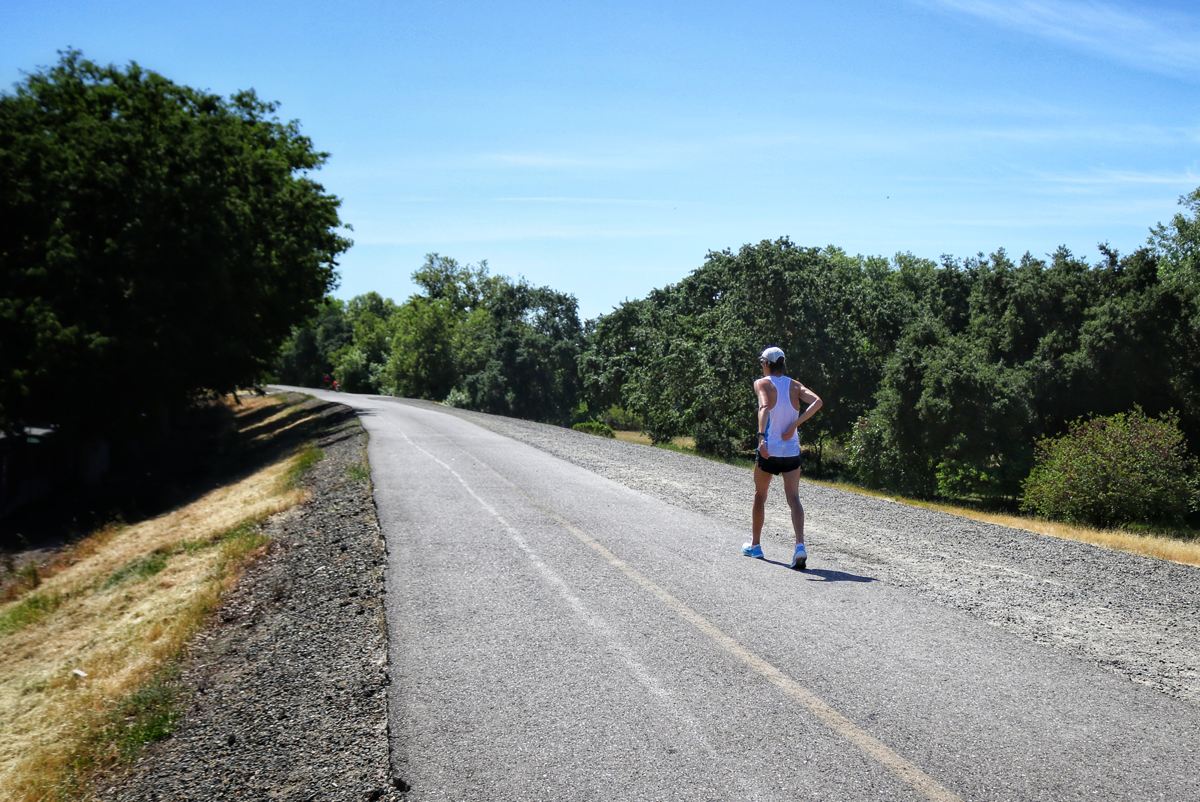
Jim taking a walking break out of the aid station after passing the 50-mile mark. Photo: Jocelyn Schmidt/Fleet Feet Folsom
Plus Eric Senseman was riding on the back of the lead car and they’ve still got the camera on me. I was like, “You guys need to get this camera somewhere else.” The body shuts down when, mentally, you realize you’ve finished something. I knew I had a 12-mile cool down still to do [to run the full 100k.] I had to finish the race to get the official split. So that was a comedy.
Eventually it came back. I drank extra water and took some salt pills on the next lap because it was getting warmer. Eventually I came back and had no real problems with running the rest of the race, but there wasn’t any squeezing. I casually did it and enjoyed running through the finish line.
There were a couple hundred people, so it definitely had some energy, too. Something really cool that Hoka did is they had the 10x10k relay and wound up setting a world record for one of them. That event brought out a lot of people. It was a separate thing and they had to stay on the left, whereas we got to stay on the right and take the inside corners and stuff. Their loop was a little different.
So between the relay and the event being in Sacramento, which is a bigger city, close to what is probably the hub of North American ultrarunning, a lot of people came out to support. In spite of the event’s late announcement, people got very excited.
The coolest part for me was that there were some old-timer ultrarunners who really connected with it. The next day, Pat Reagan and I were walking on the trail and this guy stops and was like, “Did you guys run that race yesterday?” I was like, “I hope you can’t tell from the way we’re walking.” I guess we were wearing some Hoka stuff. It was this older guy–in the age 50 to 60 range–and he said his first ultra was where the South African set the world record in the 50 mile. For this guy, this was full circle.
Then you talk about Bruce Fordyce, a nine-time Comrades winner. He set multiple records. And then Barney Klecker was a super-dominant ultrarunner in the U.S. who set all sorts of course records. To flirt with names like that in the sport, on a legitimate time in a road event, is pretty cool. I feel like it legitimizes both that era and what, nowadays, we’re doing on the trail. We’re still fast and strong, but a lot of us prefer to do it on the trails.
iRunFar: It’s just more fun.
Walmsley: It’s not as intimidating to do that, yeah. It’s easy to go get lost and casually do it, and let the hills, terrain, and weather invoke that suffering for that training effect. Whereas on the roads, there’s not as much variability. Your pace is what dictates the most suffering. That’s how you get your heart rate and your workout in.
Yeah, it’s been interesting. It was fun. I learned a lot from this that I’ll be able to apply in Comrades training next year and in the marathon.
iRunFar: What did you learn from it?
Walmsley: I need to do a lot more on the roads, and on asphalt. I need to get in and bang up my legs a lot more because it’s just a much harder surface than the trails. Even though I could be doing a lot of vert on the trails, it’s a different pounding. Then the patience aspect. Just stay patient and trust that you’re on the right pace. I always get antsy, honestly. You’re betting against someone if they’re ahead of you. You’re basically calling B.S. and saying they’ll come back, if you think your pace is right. You gotta’ be patient, and then at a different time in the race, you make up what leads you gave out and it’s time to start hunting. That’s a cool way to race, but it hasn’t necessarily been my typical tactic.
As you keep pushing the limits, whether it’s course records on the trails or road ultras, which are more standardized, you end up paying back more. So, in this case, losing that patience and that caution phase that I wanted to keep. Clicking 5:20 miles, it’s just kind of stupid in retrospect. At the time it loosened up my back and legs. But maybe once that happened, it should’ve been maybe two or three miles and then I settle back on the [correct] pace. It would’ve been a much smoother day. Even with the 50 mile, I would’ve walked away feeling really positive about it. Whereas in this case, I got myself into a hole in the middle of it. But it’s cool to see that kind of trail strength come through and still be able to hold on no problem. Yeah, it still hurts.
iRunFar: Despite having other athletes in Project Carbon X, it still felt like it was kind of set up to be ‘The Jim Show.’ You had the best chance to get the 50-mile and 100k world records, I think. Did it feel like that to you? Did it add pressure?
Walmsley: I would say that in race week, that came a bit more to fruition. But Tyler Andrews had really ambitious goals and ran really courageously. It’s one of those things where ultrarunning doesn’t necessarily reward courage. It rewards patience. Yeah, these are a lot of Bruce Fordyce’s words, it’s all about the caution and waiting. He’s the king of the second-half comeback. I’m not sure that I definitely agree with that, but it’s kind of wise words for everybody to heed.
Hideaki, the way he approached it before–there’s a language barrier so it was tough to [totally understand his race plan]. In the end, he went out a bit aggressively. It probably would’ve been perfect to tuck up with him a lot longer–maybe 30 or 40 miles. Then we would have had double the pacers. Running with him, he paced it very well for a fast start because through 40 miles, he was probably still in the 5:40 to 5:50 per mile range. Whereas, when he was at the 50-mile mark, he was down at 5:56. And by the time he finished, he was a bit slower.
You can see how the day took its effect. The course was a little hillier than what most of us were expecting.
iRunFar: Was it helpful at all that the course was a little hillier? It’s not what you were expecting, but could that in some ways have been easier than a pancake-flat course for that long?
Walmsley: That’s still debatable. I’m not sure I know the correct answer. The hills felt fine and were fun when I felt good, but once you start getting into suffer mode, those hills really start punching you. They’re not hills in the trail running sense, but when you’re pushing the pace the hills start punching you. It’s not early that they punch you. It’s late that they punch you. I think everybody felt that.
In general the event was really successful because part of the shoe was wanting to push limits–what Hoka terms the ‘X’ area. Especially trying to flirt with two records in one race, it was definitely unknown. On that day, they weren’t both in play, but I think that idea of try to do it was pretty cool.
iRunFar: You mentioned the shoes, the Hoka One One Carbon X. And this event was called the Project Carbon X, so it was focused around this shoe in part. Can you tell me a little bit about it?
Walmsley: Yeah, so it’s a dual layer, it has got what they call RMAT, which is a rubberized foam. So it’s not just a foam shoe on the bottom, it’s rubberized. It holds up really well on the roads. Once I start taking it on a dirt road or on some trails, rocks chew through it pretty well though. And then the next layer is a new foam layer. I think it is the first shoe that they are releasing [with this foam.] But as athletes we have seen it in a couple of prototype shoes, and it’s a really responsive foam layer. Then it has a carbon plate. And then the geometry puts you in a really cool–I guess up tempo would be the best way to describe it–forward motion that is fun to do workouts and long, up-tempo runs in. Pushing 100k in it was tough for me. The shoe was fast and responsive. In 100k, combined with me not training enough on the asphalt, it was an aggressive shoe.
iRunFar: From the rocker or just your feet getting tired or banged up?
Walmsley: My feet and didn’t feel banged up. It was with the rocker being pitched forward. Most people will use the shoe in that half marathon to 50k range, and I think it will be perfect for that. I talked to Pat Reagan afterward and I was like, “You have 100k in four months. What shoe will you wear?” And he was like, ” I’m definitely wearing the Carbon Xs.” So Pat really loved them. I just need to train more on the asphalt, to be honest. I was surprised how my legs got banged up compared to trail ultras.
iRunFar: So it’s the rocker that’s pretty aggressive, meaning it’s not as helpful if you are going a slower pace or something like that?
Walmsley: It depends, because I don’t think Pat was as banged up. He was doing more training on the roads. But he also has a little more of a shuffler stride compared to me. A little bit of it also depends on my stride. As much as I bounce, doing that for 100k, I’m probably going to get rocked on the roads no matter what. Overall it’s a fun, up-tempo shoe that I feel like you can do a lot of different paces in, definitely your workout go-to shoe.
iRunFar: Were you involved in the development at all?
Walmsley: No, not really. The shoe started getting whispers about mid-to-late last year. I heard there was a shoe coming. They were keeping it in wraps pretty good. They have another carbon shoe, the Carbon Rocket. Both shoes they have kind of kept closer because with the geometry and carbon plating going into shoes nowadays, brands are more protective about what differentiates their shoes. I think Hoka feels like they nailed it. There is one world record under the shoe’s belt, and maybe there will be more to come.
iRunFar: Yeah. You wouldn’t take the Carbon X and convert it over to a 50k trail shoe or anything like that? It is pretty specifically a road shoe?
Walmsley: I have mentioned that to them because it is a fun shoe to run in. When you get on the trail you need some more rubber on the bottom. And once you put rubber on the bottom, components of the shoe and the carbon and the foam will change. I have brought it up to them, “Hey what do you think about converting this?” I love the idea of trying to test it on a longer course. Western States is really runnable, so what could you do in this shoe there? That would be a cool question. They would have to change the color from white. It is a much more complicated thing than just putting some rubber on it because you would completely change the shoe’s feel. Right now they have the feel of the shoe dialed a specific way that is fun to run in on the roads.
iRunFar: Gotcha. As an aside, you are very careful in using the term ‘world best’ versus ‘world record.’ What you say to the people who say that your 50-mile time is not a world record because the IAAF and IAU don’t recognize the distance in record keeping?
Walmsley: The history is there, and I don’t care what people call it. I beat Bruce Fordyce’s best 50-mile time, so tell me something against that. There are people that have ran 50-mile distances that legitimize it in its own self. I have even been reading on [iRunFar] that it could get ratified by the Guinness Book of World Records and I think when Bruce made a post about it he had a picture of a Guinness Book of World Records certificate sort of thing. I don’t know, it’s an important distance in American running because it’s a very old record and the oldest record in the USATF record books. For us Americans, it’s as legitimate as anything else.
iRunFar: Gotcha. I just wanted to get your thoughts on that. In the coming months, you’ve got Western States. You said you didn’t totally tailor your training leading up to Project Carbon X toward that, that you also incorporated Western States training. How does that change now? You have run Western States a bunch of times; you’re coming off some road/50-mile/100k training. What does the next month and a half look like?
Walmsley: It’s a shorter block than usual because of Project Carbon X. But I feel pretty confident with where I’m at. My legs feel good and recovered. Lately I feel like I have been rolling really good races into each other. I have been able to run the times I am trying to run, whether it’s the half marathon in January, the 50 mile in Hong Kong, or some other short races. Things have gone well and I’ve stayed healthy. I have good confidence knowing that things have gone so well to just roll into another training block, stay healthy, get clicking, and show up ready to have a really big effort on race day.
This week I will try popping back into higher mileage than I usually would [after] almost a week off and after a big race. I felt like it was important to take a little more recovery than usual. Because the races are so close to each other, I think that will pay dividends. The goal this week is around 80 miles and 15,000 to 20,000 feet of vert and getting into the [Grand] Canyon. Next week I will start going to the canyon probably twice a week. In the canyon is probably as specific as training gets for Western States. Maybe some Sedona routes that get real hot.
There is a really long high-country section at Western States that I think people from altitude definitely [have an easier time on], so just living in Flagstaff helps. Usually altitude is so much cooler that you might benefit early at Western States but pay it late. But Flagstaff is one of these areas that’s really unique for training for Western States in that you can dial in both altitude and heat.
iRunFar: Nice. A couple years ago in leading up to Western States, you were doing some really huge weeks. I don’t remember the numbers, but I want to say approaching 200-mile weeks. I could be exaggerating.
Walmsley: No, no, no.
iRunFar: What were you doing a couple years ago?
Walmsley: 2016 I was probably 140, 150, and that’s about where I peak out. Nowadays when I am training for a bigger 100, I am incorporating a lot more vert. With last year’s UTMB and maybe experiencing a little overdoing it–it was a really cool training block that I am pretty proud of and I feel like I am still getting benefits from. This one probably won’t be quite as high just because I have had such a good, consistent rolling schedule where I feel so healthy, strong, and confident about how long I have been doing it now.
iRunFar: So consistency over peaking.
Walmsley: Yeah, because I still have August in mind. I would love to get up to around 130, 140 a couple weeks in a row, but I probably won’t go above 140 this year.
iRunFar: Gotcha. Thank you so much for chatting and congrats on that world record. What an accomplishment.
Walmsley: Thanks so much, Bryon.
